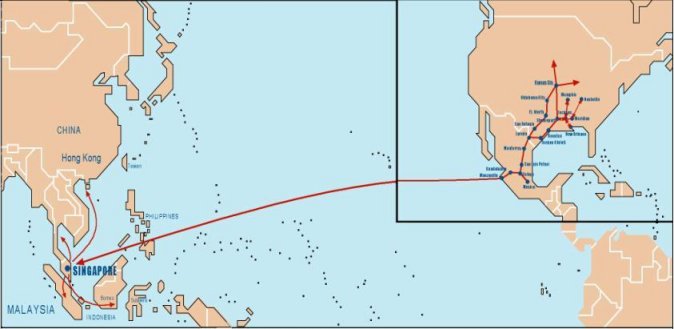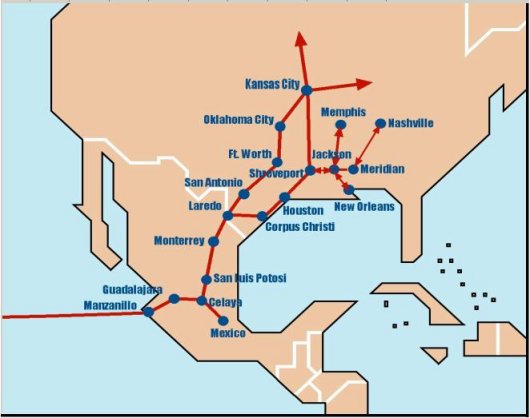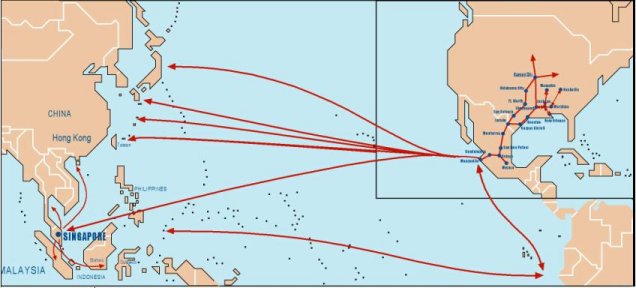http://web.archive.org/web/20031010141546/http://naitcp.org/
Conceptual Draft
October 9, 2002
The Trans-Pacific Multimodal Security System
Overview
An important step towards the further integration of Mexico with its APEC trading partners is the development of a modern multimodal security system between North America and Asia. The backbone of this new system will be frequent maritime routes between selected Asian ports and the Mexican ports of Manzanillo and Lázaro Cárdenas. These sea routes will be supported by enhanced rail service running through the heart of North America. TFM and Ferromex, in coordination with Kansas City Southern and Union Pacific, will be the workhorses hauling cargo north out of the ports of Manzanillo and Lázaro Cárdenas.
Manzanillo is Mexico’s busiest Pacific port and will be the first seaport incorporated into the Trans-Pacific Multimodal Security System (TPMSS). Subsequently, the port of Lázaro Cárdenas will be added to the program. Several Asian transshipment and gateway hubs such as Singapore, Hong Kong, Shanghai, and Kaoshiung could realize quantifiable long-term benefits by participating in this initiative. Cargo generation programs, customs modernization, infrastructure enhancements, operational improvements and the use of Intelligent Transportation Systems (ITS) will help justify frequent maritime service between Mexico and Asia. Furthermore, secure unit-train service from Manzanillo and Lázaro Cárdenas to points such as Kansas City, Fort Worth, Chicago, Shreveport and Oklahoma City will help create sufficient cargo volumes to warrant more frequent trans-Pacific shipping routes between Asia and Mexico. The TPMSS constitutes an innovative public/private partnership that can be readily duplicated throughout the APEC region.
The essence of the TPMSS is to build additional transportation capacity in APEC region, realize operational improvements, implementation of innovative security and customs protocols while providing Mexican businesses with direct access to globally competitive multimodal systems. The project proposes the development of a secure and agile transportation system to increase current capacity and, in the initial stages, will utilize the Kansas City SmartPort as its strategically located inland port in North America.
APEC Principles advanced by the project:
- Trade facilitation & capacity building
- Full participation of smaller economies and SME´s
- Public/private partnerships
- Enhanced security through customs coordination & technological innovation
In terms of capacity building, the project seeks to create both the “hard” and “soft” infrastructure necessary for Mexico to develop direct multimodal links with its Asian trading partners and to increase overall APEC transportation capacity. Together, the parties will intensify economic, technical and customs cooperation between North America and Asia. Such cooperation will increase trans-Pacific trade while helping all APEC economies participate in the global economy from a position of relative competitiveness.
The project promotes full participation in that Mexican businesses will be afforded equal and facilitated access to global trade. Currently, Mexican business is highly dependent on the U.S. transportation system for its trade with Asia. This dependency has served to increase costs and limit direct business links between Mexico and Asia. The development of frequent, secure and direct maritime service between Mexico and Asia would facilitate trade, reduce costs and boost economic growth.
The public and private sectors are collaborating closely on the TPMSS. A close and continuous dialogue between the project stakeholders has established a platform for envisioning, defining and formulating regional initiatives designed to facilitate trade and promote global security.
Counter Terrorism Strategy – promoting enhanced security
The recent terrorist attacks in the U.S. have heightened concerns for security within the APEC region. The TPMSS will promote greater multilateral customs coordination and work to increase the integrity of cargo shipments as a means to advance the Shanghai Counter-Terrorism Declaration. The terrorist attacks illustrated the critical yet fragile nature of the international transport system. For the global economy to flourish, the transportation system must continue to provide safe, secure, efficient and reliable movement of goods.
In October 2001, the APEC Leaders called for the implementation of projects designed to strengthen activities in the area of critical sector protection, including telecommunications, transportation, health and energy. Also, in order to allow customs authorities to better enforce laws while simultaneously minimizing the negative impact of new security programs on the flow of goods, the APEC Leaders have called for the implementation of enhanced customs communication networks and the development of a global integrated electronic customs network.
Founded on basic APEC principles, the TPMSS proposes to serve as an APEC Pathfinder risk management initiative for the trans-Pacific movement of cargo. The 2002 ABAC Chair Javier Prieto has proposed that several APEC economies create a public/private working group that would jointly develop the TPMSS as a pilot project for the key security programs such as the Business Anti-Smuggling and Security Coalition (BASC), the Container Security Initiative (CSI), the U.S.-Mexico Smart Border plan and the U.S. Customs - Trade Partnership Against Terrorism.
Security Enhancement # 1: Advancing Existing Security Initiatives
Ø Business Anti-Smuggling and Security Coalition (BASC)
The TPMSS could easily serve as a pilot project for the BASC program. ABAC subscribes to BASC’s efforts to unite the public and private sectors to combat terrorist activities and narcotics smuggling via legitimate commercial activities. The TPMSS envisions the use of Intelligent Transportation Systems (ITS) that will permit officials to oversee the security of the entire manufacturing and shipping processes thereby creating a more security-conscious environment at manufacturing plants. Eventually, Mexico would like to see the entire TPMSS route obtain BASC certification.
Ø Container Security Initiative (CSI)
The TPMSS can also serve as a pilot project for the CSI. Approximately 90% of the world’s cargo is transported in containers, including half of the goods that enter the U.S. Therefore, container security is a vital issue. With the proper risk management and ITS, the TPMSS could help increase container safety in the ports of Manzanillo and Lázaro Cárdenas by establishing security criteria to identify high-risk containers and pre-screening containers before they reach international borders. The TPMSS will also proposes providing facilitated treatment for those shippers who use advanced technologies such as laser sealing, bar coding and light or temperature sensitive alarms in containers. Advance information sharing would also be a significant part of the TPMSS’s customs protocols. Vital information along the route would be shared through ITS between all of the participating economies.
ØU.S.-Mexico Smart Border plan
As part of the U.S.-Mexico Smart Border plan, laser-scan identification cards for frequent border cargo crossings, X-ray facilities, shared computer databases and special express lanes for pre-inspected shipments will be included as integral parts of the TPMSS. All of these provisions will help increase security while facilitating the movement of legitimate trade.
Ø U.S. Customs-Trade Partnership Against Terrorism
The TPMSS could be the genesis of a public/private initiative to build cooperative relationships that strengthen overall supply chain and border security. Through a TPMSS pilot project, APEC Customs officials could work with the private sector to ensure the integrity of their business practices and communicate their security guidelines to their partners within the supply chain.
Security Enhancement #2: Multiple Security Checkpoints
Currently, Mexico is working to create an ITS Security plan for the TPMSS. The preliminary security plan foresees a system that will serve as a risk management pilot project with a series of physical and virtual checkpoints. Goods will be sent via secure containers, pass through several X-ray arcs at different locations, and have ITS lead them along the entire route.
For example, it is envisioned that goods shipped through the TPMSS could travel the following path. First, goods will undergo an initial security revision at the shipper’s location in Southeast Asia and/or during their transshipment in Singapore. Singapore will then send advance notification to Mexican and U.S. Customs with the corresponding “pre-clearance” information on the cargo. When the containers arrive at Manzanillo or Lázaro Cárdenas, they will proceed through an X-ray arc, but will not clear Mexican Customs. Any containers with anomalies will be removed from the special in-bond regimen. If no anomalies are detected, the containers will head north on double-stack unit-trains. The unit trains will be tracked by a GPS system and monitored by ITS during the entire journey. When the train reaches the U.S. border, the containers will pass through yet another X-ray arc, and will clear U.S. Customs under the new electronic manifesting system. Again, any containers with anomalies will be removed from the unit train and inspected immediately. The cargo will then travel non-stop on Kansas City Southern or Union Pacific trains, while being GPS/ITS tracked, to an inland trade-processing center in cities like Kansas City, Chicago, Ft. Worth or Oklahoma City. Upon arrival to the inland port the containers could be subjected to another full customs inspection and then trucked out to the final destination.
Another part of this agile transportation system involves special treatment for “AAA” cargo. For a business to be certified as a “AAA” client under the pilot project, it must pass a series of rigorous information sharing, security and best practices requirements as outlined in programs such as BASC and CT-PAT. The TPMSS will lobby for the provision of facilitated treatment for “AAA” clients. The argument is sound, authorities can make better use of equipment and personnel while also increasing the effectiveness of interdiction efforts by focusing their efforts on truly risky or unknown shippers instead of companies participating in security programs such as BASC. Security measures like “AAA” client certification and ITS will enhance the overall system of multiple checkpoints throughout the entire TPMSS.
Security Enhancement #3: Reducing Border Congestion
The TPMSS could help reduce border/port congestion and decrease the time demands on security personnel. Congestion at the border and in ports creates pressure on personnel to keep traffic moving. As a result, inspection levels and/or thoroughness can sometimes suffer. It is now widely held that the border should be the last line of defense against terrorism and not the first. In response to this problem, the TPMSS is working towards the use of advance information sharing and pre-screening protocols as a means to more efficiently use border personnel and equipment. Further, the TPMSS encourages authorities to study the future use of in-bond customs clearance protocols and ITS to divert traffic around congested border and port inspection facilities to strategically located inland trade-processing centers as a means to reduce border congestion and increase inspection levels and thoroughness.
Security Enhancement #4: Increased Inspection Levels at Inland Ports
The use of inland trade-processing centers in Mexico, the U.S. and Canada as state-of the-art security check points or launching pads will lead to increased inspection levels while simultaneously promoting the agile movement of cargo. Once the inspection and ITS systems are developed, they would be implemented in strategic inland ports in Guadalajara, San Luís Potosí, Guanajuato, Monterrey, San Antonio, Ft. Worth, Oklahoma City, Kansa City and Winnipeg. Security concerns demand an increase in the quantity of goods inspected before they cross international borders. Unfortunately, increasing the number and thoroughness of inspections at ports or at the border can put pressure on personnel and infrastructure creating longer lines and costly delays for business. Inland ports can help alleviate congestion.
The status quo is not an option. The aggressive use of risk management inspection policies is a central part of the TPMSS. The TPMSS proposes working towards “smarter” inspections at the border that simultaneously increase security parameters and facilitate the flow of goods. Diverting “AAA” cargo around border / port inspection facilities can be an integral part of the new global security paradigm. By diverting “AAA” cargo to an inland trade-processing center, as proposed in the TPMSS, pressure on border / port infrastructure and personnel would be reduced. Tracing and tracking “AAA” cargo to an inland port and the use of risk management protocols would allow border / port authorities to focus their efforts on inspecting high-risk shipments.
In conclusion, using the TPMSS as a pilot project for programs such as BASC, CT-PAT and CSI would be a positive contribution to global security. The TPMSS could be a laboratory for the development of innovative risk management, ITS and customs modernization protocols for the participating APEC economies.
The Trans-Pacific Multimodal Security System
Trans-Pacific Land Bridge
Duplication in other Economies


